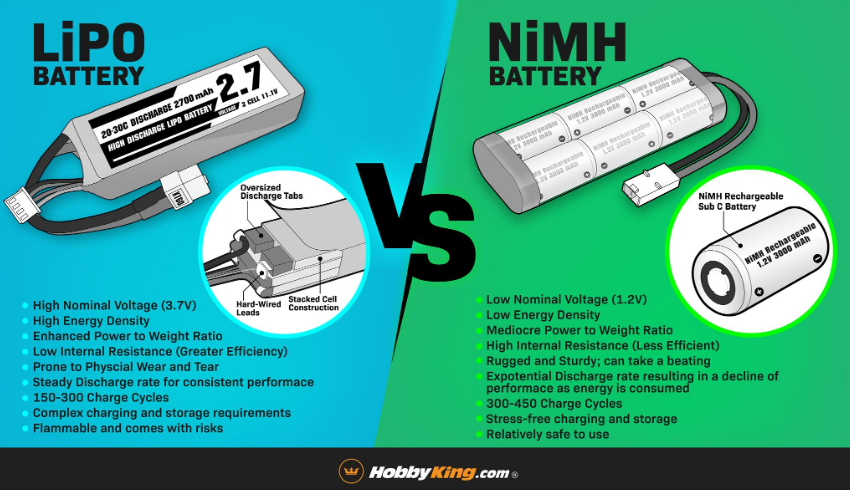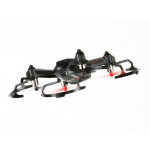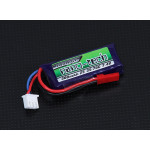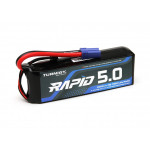
LiPo (Lithium Polymer) Vs NiMH (Nickel-Metal-Hydride): which one is better? If you asked this question 10 years ago you will find yourself in a deadlock. Heated debates on which was the superior battery was a recurring theme. However, today, LiPos are the de facto king when it comes to RC batteries.
In this blog, we look at the differences between LiPo and NiMH batteries, and why LiPos are the superior choice.
Voltage (Power) & Capacity (Run-time)
The Voltage (V) and capacity (mAh) is the first thing you should look at when comparing different batteries. Voltage governs the power or speed of your RC model while capacity, the run time.
A LiPo cell has a nominal voltage - the average voltage a cell outputs when charged – of 3.7V, while the nominal voltage of a NiMH cell is 1.2V. The difference in nominal voltage potentially gives LiPo users greater speed and power right off the bat.
LiPos are also more energy-dense than NiMH – meaning that they can hold more energy relative to their size. High energy density inherently gives LiPos two major benefits: longer run time, and improved weight to power ratio.
Additionally, LiPo batteries have a lower internal resistance than NiMH, enabling them to draw power more efficiently. High energy density combined with a low internal resistance gives LiPo batteries enhanced performance (power, speed, and run-time) in the field.
Shape, Size, and Weight
NiMH battery packs are composed of cylindrical cells tightly bundled together. Each cell is encased in a metal wrap which makes the whole composition incredibly sturdy. If you routinely run your RC models in rough terrains, you will find NiMH batteries to be the more rugged and durable choice.
However, the extra protection comes at the cost of increased weight; and weight is detrimental to speed. At the competition level, where a fraction of a second can mean winning or losing, LiPos are naturally the preferred choice.
LiPo batteries are composed of flat cells that are wrapped together in a semi-rigid plastic film. They don't follow a specific shape or size, making them incredibly versatile - most micro or homegrown RC models use LiPos for this reason. While they are lighter than their NiMH counterpart, they are also more prone to physical wear and tear. Yet for most RC hobbyists, greater speed and performance are justification enough to forfeit durability.
Discharge Rate (Consistency)
The discharge rate simply refers to how your RC model consumes energy from the battery. LiPo batteries have a flatter and much more steady discharge rate than NiMH batteries - meaning that your RC model will perform consistently until all (or most) of the energy is consumed.
Whereas the discharge rate of a NiMH battery is exponential: as energy gets consumed, performance declines. So, if you had two RC cars with the same build but one fitted with a LiPo and the other with a NiMH (same voltage and capacity), after two minutes the NiMH model will start to lag. Hence, at the competition level, it is rare to find anyone still using NiMH batteries.
Life Span (Charge Cycles)
While LiPo batteries come with a lot of advantages, one of their major drawbacks is a shorter lifespan. You can expect most LiPo batteries to have around 150 – 300 charge cycles, whereas a NiMH battery can easily log around 300 – 450 cycles.
All batteries – LiPo, NiMH, NiCad, LiHV- will inevitably lose their stated capacity and will be past their prime after continued use. Extending their life span can be achieved with proper charging and storage which we will discuss below.
Charge & Storage
When it comes to charging and storing your batteries, LiPos are more complex and demand a certain degree of discipline. You should never overcharge your LiPos past 4.2V per cell (unless you're charging LiHV packs which can go up to 4.35V per cell) or discharge them below 3V per cell; failing to do so will ultimately damage your LiPos and increase the risk of a domestic fire.
For storage, your LiPos need to be kept at room temperature and must retain 50%-70% of their capacity. To help you abide by these strict rules, you should always use a compatible charger with automatic safety features such as the Turnigy Reaktor Touch 300 AC/DC charger. It is also important to keep them inside LiPo safe bags when charging or storing to mitigate any potential damages.
NiMH batteries are much easier and safer to use. Unlike LiPos, they are composed of non-flammable materials which give them more leeway when it comes to charging and storing. They do, however, suffer from "battery memory" which significantly shortens their run-time if not properly maintained. You should always fully discharge a NiMH battery before charging, and fully charging them before storage. Failure to do so will cut into your battery's lifespan.
Safety
Overall, NiMH batteries are considered to be fairly safe and easy to use. They are not flammable and the worst-case scenario normally involves a short circuit problem.
In the case of a short circuit, your NiMH batteries will get very hot and may melt or set other things nearby on fire. However, if you have a designated area to charge and store your batteries, any damage incurred will only be minimal.
On the other hand, while LiPos have become a staple in the RC hobby due to their superior performance, they can also be fairly dangerous. If a single cell in the pack is exposed to air (punctured), the LiPo battery will explode.
There are two common ways a LiPo battery can get punctured: continued bashing or dropping of your battery, and overcharging. Yet, with the proper care and maintenance, a lot of RC hobbyists are finding success with their LiPos and are gradually forgetting about its predecessor.
---
Hear it First: Join our Mailing List
Sign up to receive new product updates, exclusive discounts, news, and more!






